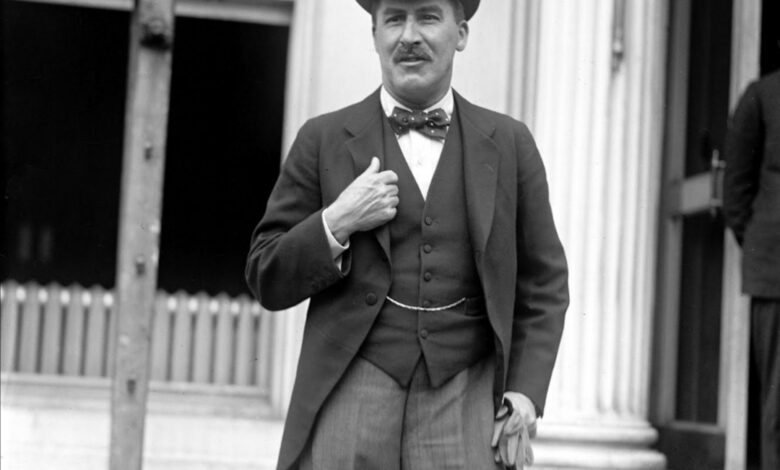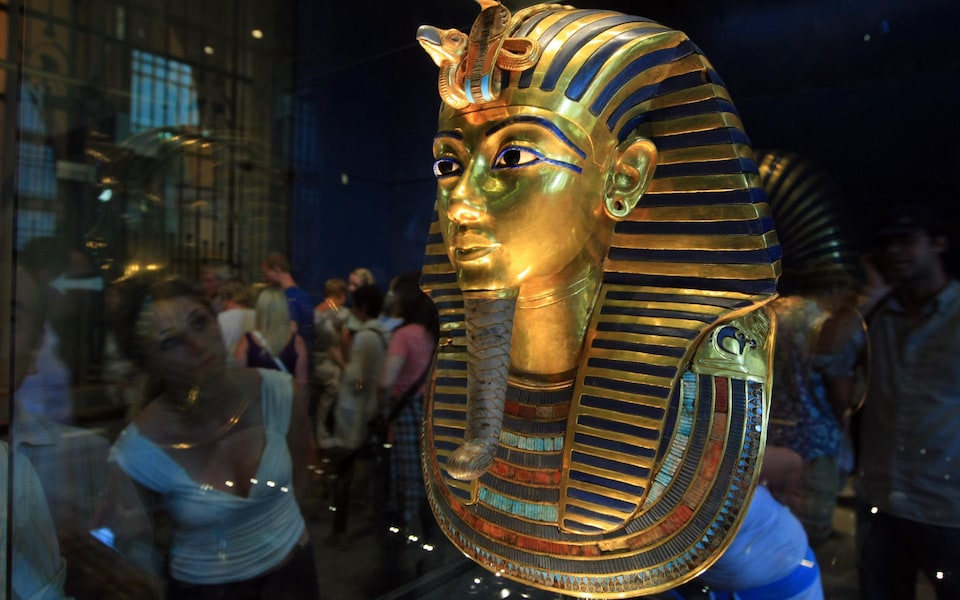
We are few days away from the celebration of the 100th anniversary of the greatest archaeological discovery in history, which is the discovery of the tomb of the young pharaoh of Egypt, Tutankhamun, who was also known as the Golden Pharaoh, as well as by the acronym King Tut.
On this unique occasion that comes once in a lifetime, there is nothing better than writing about important stations in this discovery to inform people of the exciting circumstances and events that occurred before, during and even after the announcement of the discovery of the golden tomb of King Tutankhamun.
These events are often overlooked in books and articles, because the luster of gold and the beauty of the treasures discovered in the tomb always hide everything else.
In the beginning, we must talk about the man who uncovered the tomb and recorded his name in history next to the name of King Tutankhamun.
He is the English explorer, Howard Carter, who was led by fate from a poor farm in the heart of England to Egypt to be on a date with the greatest archaeological discovery in history.
Hayward Carter was born on May 9, 1874, in a modest house in a neighborhood of London, to Samuel Carter, a painter for The Illustrated London News, and his wife, Martaha Joyce, who had ten sons and one daughter.
Three brothers of Howard Carter had passed away before he came to this world.
Howard was born weak, ill in health, and the father and mother believed that this weak newborn would not live long, so they decided to send him to his two aunts to live with them in the family’s country house away from London, maybe the countryside atmosphere would save him from the inevitable fate!
Howard Carter had no skills other than a talent for drawing, which he inherited from his father, as well as his brother William Carter, who was also an accomplished painter. Carter did not receive any formal education and relied on the school of life, as he himself mentioned in his memoirs, although he learned the principles of reading, writing and arithmetic in a voluntary school run by some women to teach the children of the poor.
The poor educational and cultural level of Howard Carter is confirmed by the spelling errors found in his first letters he was sent from Egypt when he first came to it as a young man under the auspices of the famous Amherst family.
Baron William Amherst was an aristocratic man with a fondness for arts and literature.
He was able to own a huge library of thousands of rare books and artifacts, including papyri and Egyptian antiquities, which he collected throughout his life. He had five daughters from his wife, Margaret, who loved ancient Egyptian history and pharaonic antiquities, and of course, Howard Carter got to know them through his father, who drew portraits for many members of the Baron Amherst family.
When news were circulated that Egypt Exploration Fund Committee had formed an archaeological mission to record the antiquities of Middle Egypt, led by the archaeologist Newberry, Mrs. Margaret wrote a letter to the responsible committee asking them to include the young artist, Howard Carter, among the members of the mission and to take advantage of his drawing skills.
Indeed, the commission agreed and set a stipend of fifty pounds a year for Howard Carter, or about four pounds a month, in 1890, when he was 17 years old.
Howard Carter spent a few days in Cairo before moving to Minya to start work on the project. During his stay in Cairo, he got acquainted with the famous English archaeologist Flinders Petrie, as well as visited the antiquities’ museum, which was in the Ismail Pasha Palace in Giza, where artifacts had been transferred temporarily after the Bulaq Museum sank in the flood waters, and the project to establish a new museum of Egyptian antiquities had not yet begun.
Carter, Newberry, and members of the archaeological mission traveled to Minya to start work on recording the scenes and inscriptions depicted on the walls of the tombs in Bani Hassan and Deir al-Barsha.
The mission stayed inside the tombs in which they worked.
After the completion of the registration and drawing work in the tombs of Bani Hassan, Newberry and Howard Carter moved on foot from Bani Hassan to al-Barsha through the mountains and hills, to carry out their mission there.
However, a dispute occurred between the members of the team, which led to the resignation of Newberry from the mission, and accordingly Carter lost the bond and had to move and work with Petrie in his excavations at Tell el-Amarna, the capital of Akhenaten, in Minya.
So, did Howard Carter know that he would be on a unique date so many years later with this king’s son? Of course not.
During his short work with Petrie, Carter learned excavation and restoration skills besides archaeological recording, and he moved to work with many missions. His stay in Egypt was extended, so he learned Arabic and became an expert in dealing with Egyptian workers, and acquired during six years of working with Édouard Naville in Deir el-Bahari a lot of skills until he turned from a mere amateur archaeological painter to a professional archaeologist that his name began to reverberate in the archaeological community in Egypt.
After the establishment of the Egyptian Museum in Cairo, which also became the headquarters of the Antiquities Department, two jobs were created, namely, Chief Inspector of the North and Chief Inspector of the South.
The task for which this position of chief inspector was created is the enrichment of the new museum with Pharaonic antiquities.
The authority of the chief inspector of the north extended from Alexandria and the Delta to Qous in the south and he was based in Saqqara, while the authority of the chief inspector of the south extended from Qous to Sudan in the south and he was based in Luxor.
Naville and other archaeologists named Howard Carter to take over one of the two positions, so he was appointed to the position of chief inspector of the south, while the archaeologist James Edward, a graduate of Oxford, was appointed as chief inspector of the north, and each of them received a fortune estimated at LE600 per year, or LE 50 per month, which was a great wealth by the standards of that era. As a reminder, the Egyptian pound at the time was slightly more valuable than the pound sterling, which was sold for 97 piasters.
Howard Carter, who did not graduate from any school or university, succeeded in being equal to a well-educated archaeologist and an Oxford graduate.
That was just a station in the life of Carter, who took up his job in Luxor and began to carry out cleaning and restoration works for archaeological sites to prepare it for visits.
He used his relations and friendships to obtain the donations of wealthy visitors to use in his work to preserve antiquities, especially against thefts, as he replaced the doors of the royal tombs, which were made of wood, with other doors of iron.
But this did not prevent heinous thefts to from occurring during his tenure, including the theft of the tomb of King Amenhotep II, and the assault on his mummy and the theft of another mummy that was in a boat that was stolen.
Despite Carter’s certainty that the Abdel Rasoul family was behind the theft, and despite the arrest of three brothers from the family, the boat could not be found until now.
In 1904, Carter was transferred to the position of Chief Inspector of the North, to be based in the archaeological area of Saqqara.
This transfer was supposed to be a reward for Howard Carter, but unfortunately it was a turning point in his life. Only a few months later, specifically on January 8, 1905, a delegation of 15 French employees of the Electricity Company visited Saqqara.
Unfortunately, they arrived in the area while they were extremely drunk, and they misbehaved with everyone who met them, so that they assaulted the Egyptian employee, Muhammad Effendi, who was in charge of the area, as well as the security guard, who was appointed to the Serapeum of Saqqara!
After guards appealed to Howard Carter, the latter tried to contain the situation but he failed!
The drunkards went too far in assaulting everyone who confronted them, even smashing the furniture of the office of the Antiquities Department, so Carter only ordered the guards to confront them and expel them from the area.
It seems that the guards were so for such an order from Carter, so they started beating the drunken French with thick sticks and shoes until they injured a large number of them, causing them to flee from Saqqara.
The director of the French Electricity Company filed a complaint against Carter and the Egyptian guards, claiming that they assaulted the women and children who were with the French group.
Although evidence were in favor of Carter and his men in the case, including the testimony of the owners of donkey carts that transported the drunken French from Mit Rahina area to Saqqara, a decision was issued to transfer Carter to Tanta, where his stay did not last long.
Carter submitted his resignation from his position on 4 November 1905.
It is a strange coincidence that this date, November 4, when he lost his job, will become, years later, ‘the promised day’ of Howard Carter’s life…To be continued next week, God willing.




